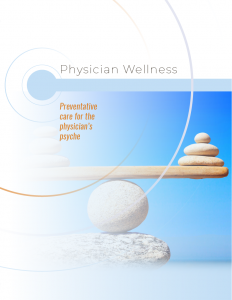We’ve heard a lot about the syndrome of Burnout that plagues the medical community. Like many diseases of opportunity, however, there are vaccines and preventative steps those at risk can take to delay or even prevent the onset of something as insidious and potentially deadly as Burnout. As physicians, we spend countless hours learning the ins and outs of everything that ail our patients…..it’s time to turn that healing energy inward and learn how to be well in the medical community.
What is Wellness and Why Does it Matter?
What one defines as wellness may vary vastly from the person sitting next to. According to Merriam-Webster, wellness is defined as “the quality or state of being in good health especially as an actively sought goal.” While it’s easy to take a look at that statement and say “my BP is excellent, I’m breathing…I’m fine,’ it’s the end of the definition that holds the key to what physicians struggle with; it implies that being well is something we should not only desire, but should actively be seeking out and working toward on a regular basis. Too often, physicians use a multitude of excuses to justify why Wellness isn’t a priority or doesn’t seem attainable: too many patients to see! Endless paperwork! And let’s not forget the always popular notorious EHR. Add in the normal stressors of everyday life and all of these are valid reasons to feel overwhelmed and push off any form of self-care. The fault in this logic is, in the end, the old adage is true: if you don’t care for yourself first, you are of little or no help to anyone else.
It’s All About the Boundaries: Finding that “Sweet Spot” in the Balancing Act of Work and Home Life
No one survives the rigors of physician training without being driven. The ability to perform at high levels under often immeasurable stress while being efficient is like having a super power you really don’t want to use; you’ve spent so much time honing these skills it’s extraordinarily difficult to turn them off when you return home. While it’s important to have these tools in your toolkit, it’s also important to learn how and when to use them. By establishing boundaries for yourself, you are taking a crucial first step in prioritizing your own wellness. A very basic way to do this is knowing your Core Four:
- What are you capable of?
- What are you not capable of?
- What are you willing to do?
- What are you not willing to do?
This might seem like a very simplistic exercise but, like the tool of Occam’s razor that we are taught in medical school, the simplest explanation is often the most likely. Taking the time to know what makes you tick, what your basic needs are, and, most importantly, what your deal-breakers are, is vital to establishing what being well looks like for you. Like medicine, this list will shift and evolve over time. Just as we don’t manage diabetes the same way we did 20 years ago, the answers to these questions will be in a constant state of flux as you grow in your personal life and career. One of the most important weapons a physician wields in their battle against illness is the ability to adapt: it’s time we applied that to our own Wellness.
Finding Your Why:
I recently did an exercise with our residents on doctor-patient communication skills. We asked psychology doctoral students to act as standardized patients in a difficult patient encounter. Residents were tasked with navigating what is unfortunately a common scenario that we encounter and the entire group did a feedback/debrief after the event. As with any good discussion, the discussion flowed freely and inevitably, when discussing how to process patients that are emotionally taxing, the conversation turned to Burnout. Being the nurturers we are, we talked about how important it is to take time for yourself, employ de-stressing techniques, all the things we are “supposed” to do to manage the stress of practicing medicine. Engage in a hobby! Take time for you! And it was going great! Until one of my residents very honestly and bluntly asked “what does that even MEAN?!? I don’t have the time for anything like that. How do I figure that out?” Two things happened for me in that moment: I made a mental note to check in with my residents at a later time to make sure they were having their needs met….and I found myself having to define what it meant for me to be well. An upper year doctoral student again used simplicity to shine light on the path that now appeared murky: he plainly sated “you need to do what brings you joy.” Like most of medicine, the solution is that simple and that complex.
The exercise of finding your why can vary depending on what hat you are wearing at the moment: are you struggling with why you went into medicine in the first place? Or are you looking for fulfillment personally, whether it be as a spouse, parent, child, friend, or as just being you? Taking the time to periodically reflect on your core values, be introspective, and sit with your feelings is crucial to finding that spark of joy and important to your Wellness.
Making Room for You: Incorporating Wellness into Every Day
Once you are able to define what brings you joy and you remember what your why is, the next logical step is devising a strategy to incorporate these tools into your everyday routine. I recently attended a departmental training entitled “The Myth of Multitasking” by Dave Crenshaw, a well-known business coach. Going into this, I found myself caught between being intrigued and mumbling to myself “I multi-task like a boss.” Not only was this seminar very engaging, it taught me 2 very important lessons, both of which I surprisingly already knew from practicing medicine. The first is that multi-tasking is really not all it’s cracked up to be. Again, I use the super-power analogy: by trying to do too many tasks at once instead of focusing on one thing at a time, we are never really present in the moment. The consequences of this are vast: we devalue the work or relationship we claim we are focused on and it costs that much more time and effort to accomplish the goal. The second lesson I took to heart is that the to-do list is the devil’s tool (something I usually reserve for quick texts in our EHR). If we don’t clear that list, Mr. Crenshaw pointed out, what do we do? We transfer it to another list. And the list is never really done. When a patient presents to you with an exhaustive list of things they’ve “saved up” to address with you, it’s overwhelming, just as it is for them when we inundate them with too many tasks. A helpful tool for navigating this scenario is using a schedule, which was exactly what was recommended in this workshop. We tend to keep appointments, whether it be taking our dog to the vet, soccer practice, or getting a mammogram. By performing the simple act of putting time for you on your calendar, you are giving yourself the message that your Wellness matters. I’m sure some of you are reeling at this thought, thinking “I don’t have time to do this!” The truth of the matter is you don’t have time to not do this. If you’re intimated, fall back on everyone’s favorite task-making tool: make these SMART goals. Make your “appointments”:
Specific
Measurable
Attainable
Relevant
Time Based
Let’s say you like to garden. So much so you decide to become a Master Gardner. So you do a little research…..and realize exactly how many hours this will entail. One option is to abandon this entirely and embrace the weeds in your planting beds. The message you internalize creates a negative feedback loop: this is a waste time you don’t have, so you’re moving on. Option 2 is to be SMART about this: grow a few herbs in your kitchen window; clear out one bed this season and plant a few hardy flowers. By starting small and creating a schedule, you are setting yourself up for success in the task at hand, which creates a positive feedback loop: you kept your appointment, and you really do have time to be well.
The process of going through change only happens when that change is less painful than the status quo. You have spent years placing your wellbeing at the lowest rung on your ladder of priorities. Don’t wait until you are suffering from Burnout to embrace the need to be well. By shifting your thinking on the importance of Wellness as a physician, you are taking a giant leap forward in learning to be well.
To read more on physician wellness by author Dr. Megan Vermeulen click the image below to access Physician Wellness – Preventative care for the physician’s psyche.
Dr. Megan Vermeulen is the Director of Content Strategies at physiciancareerplanning.com and Associate Program Director at Rowan University SOM Family Medicine Residency Program.









